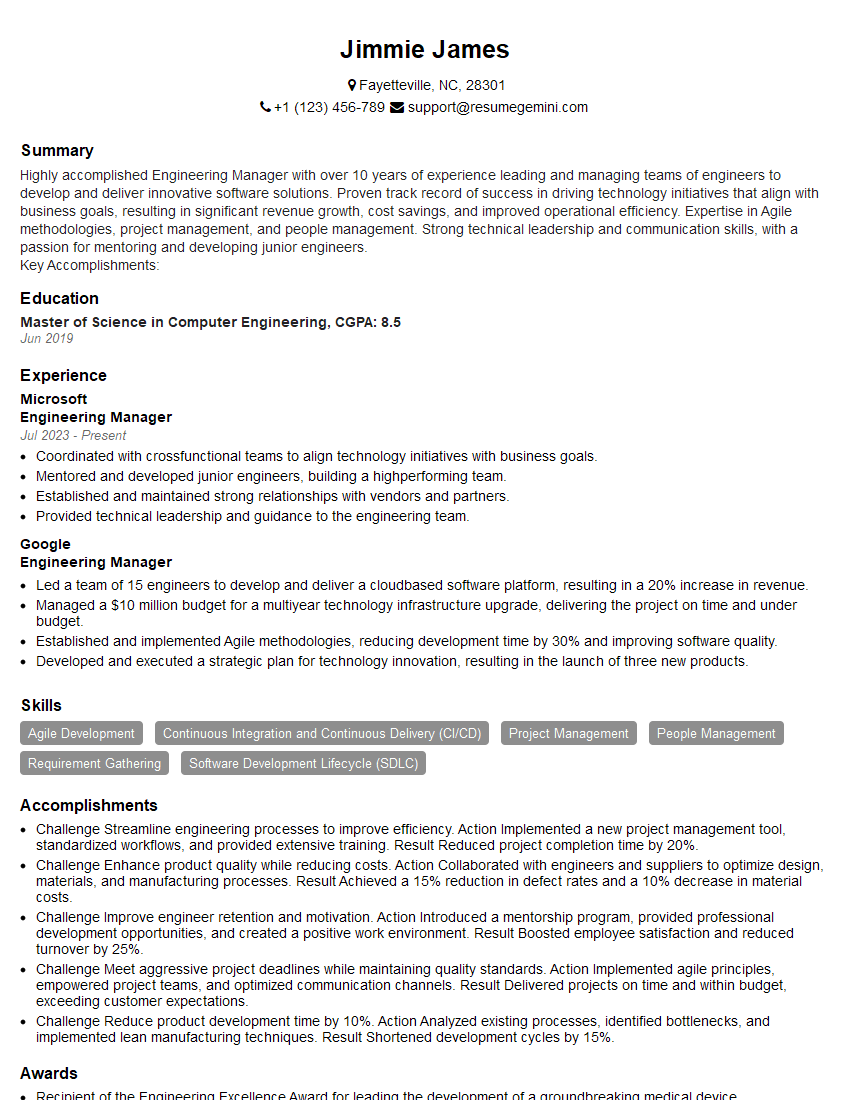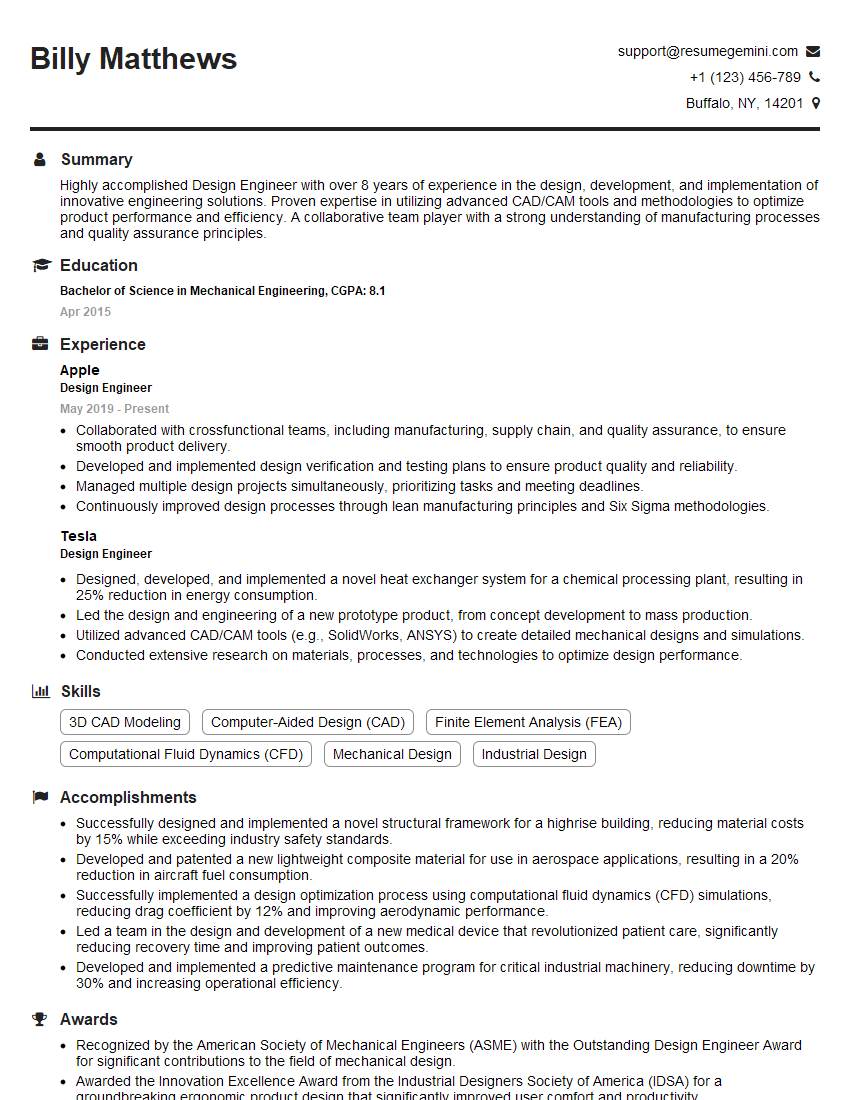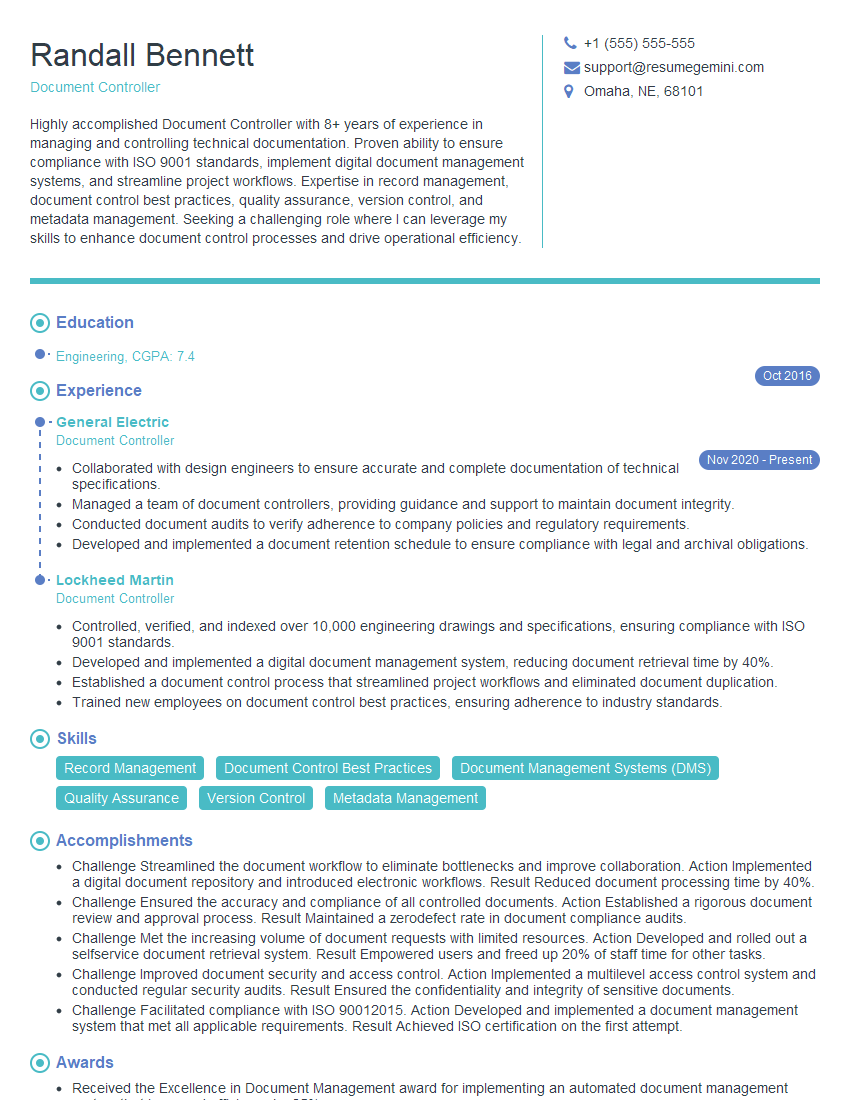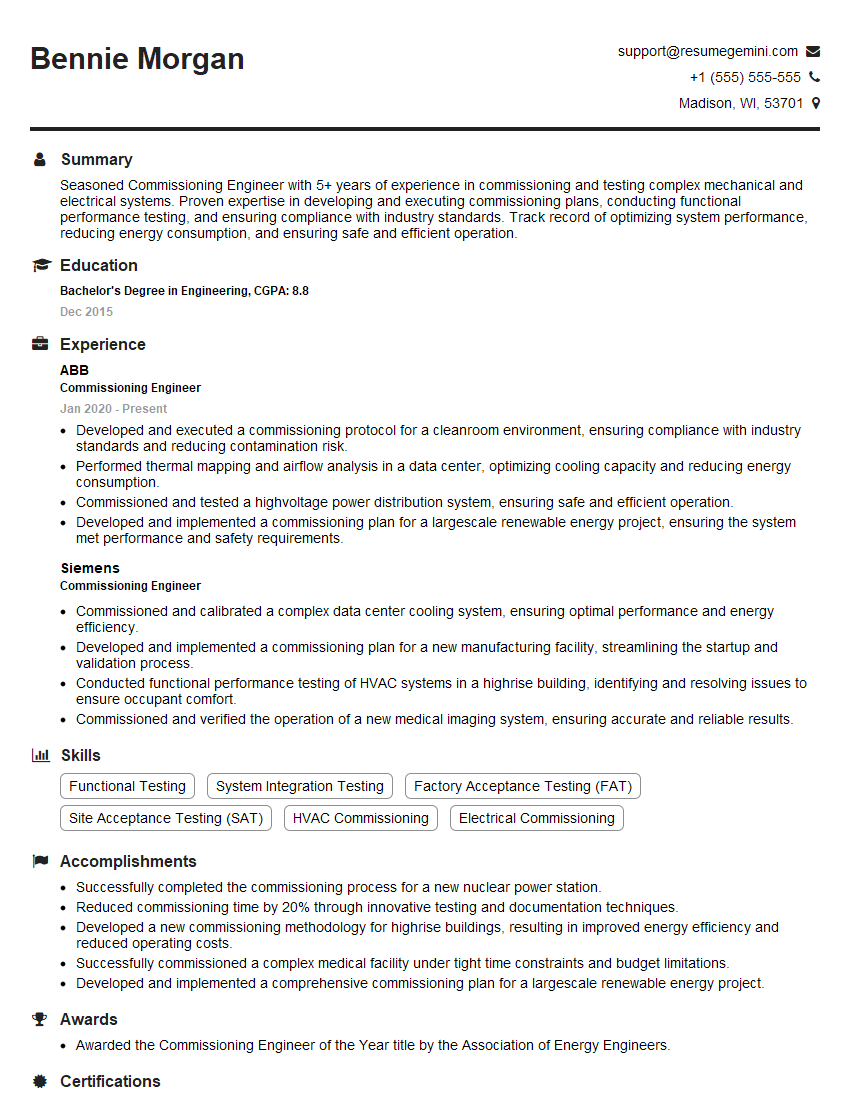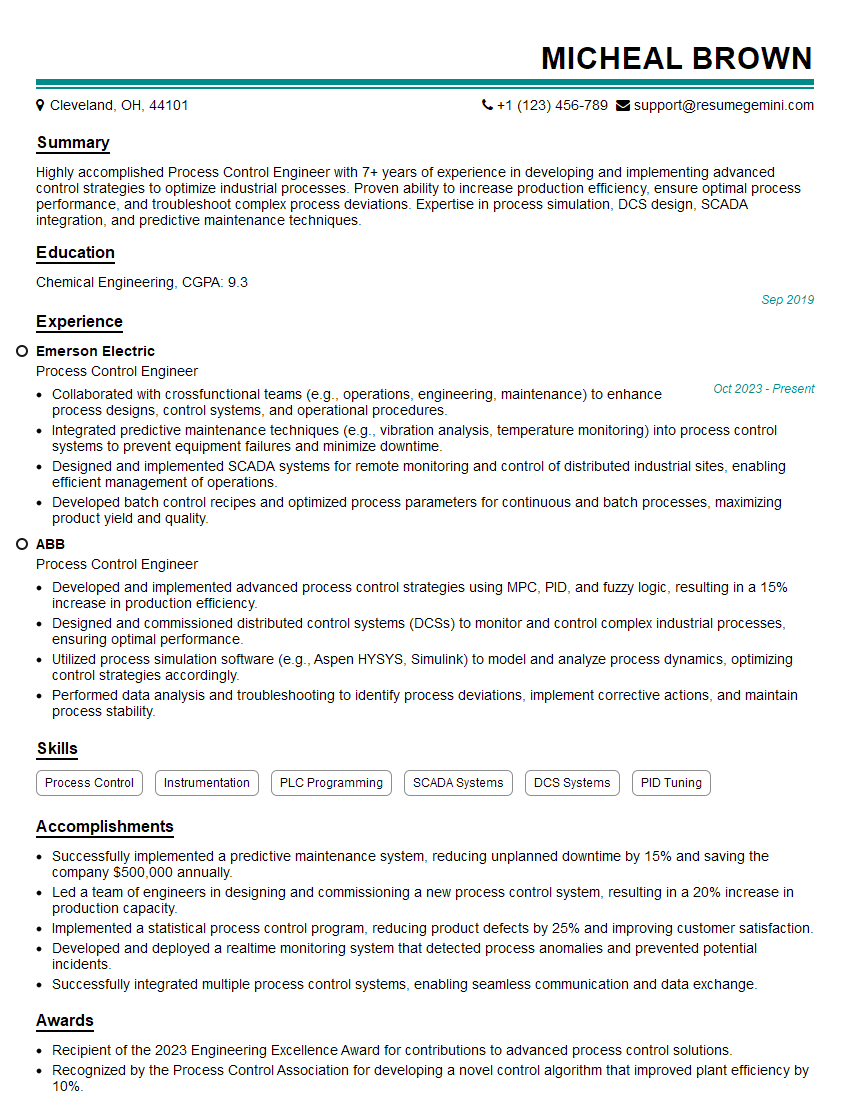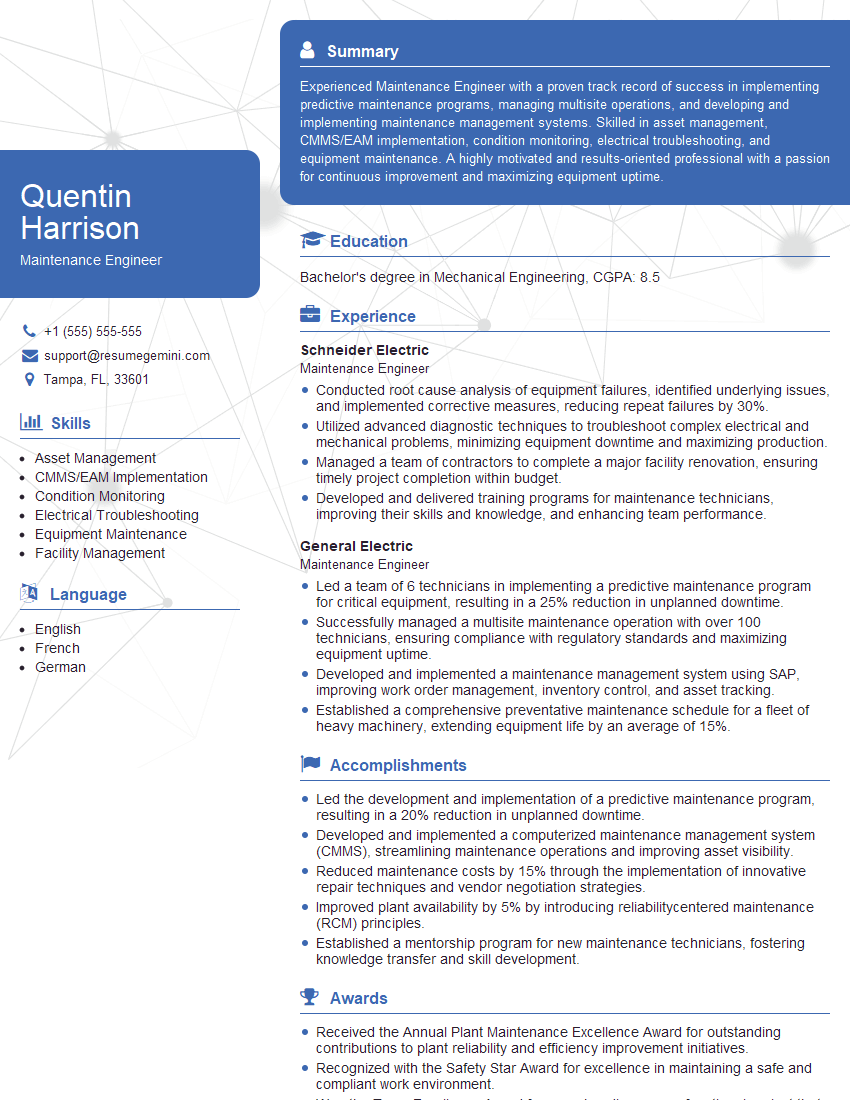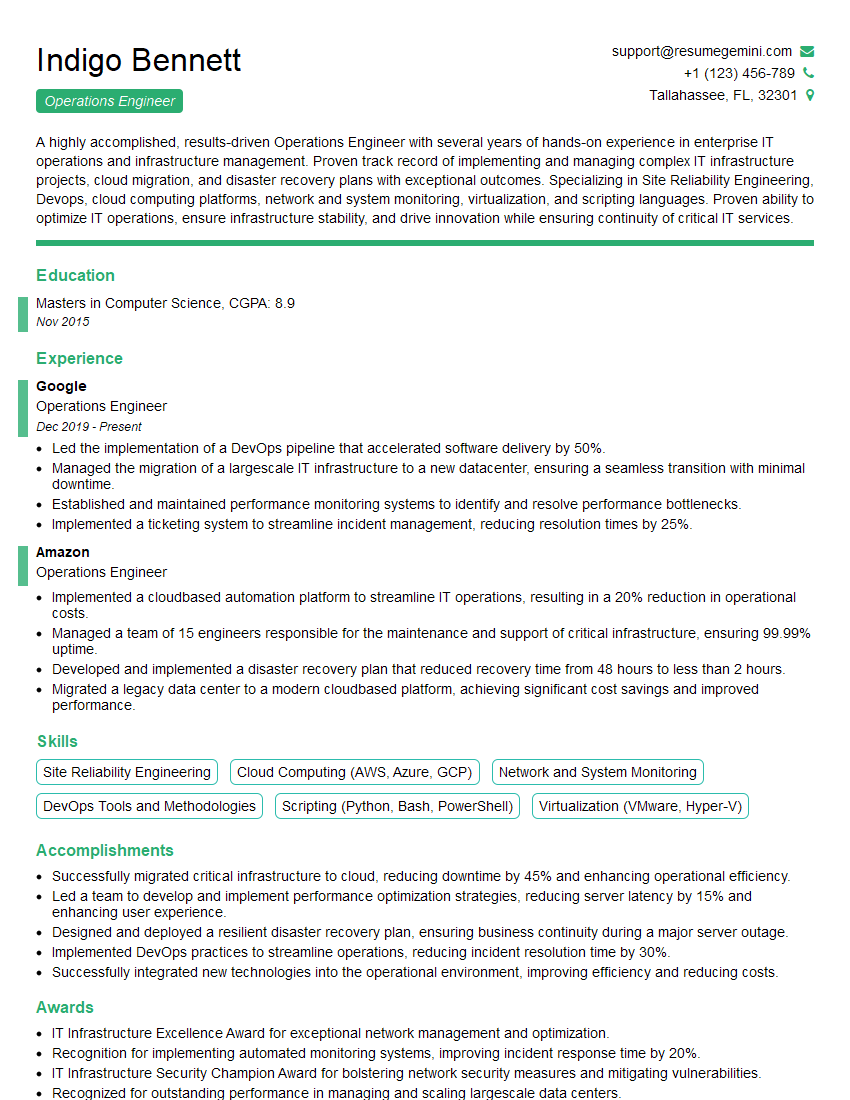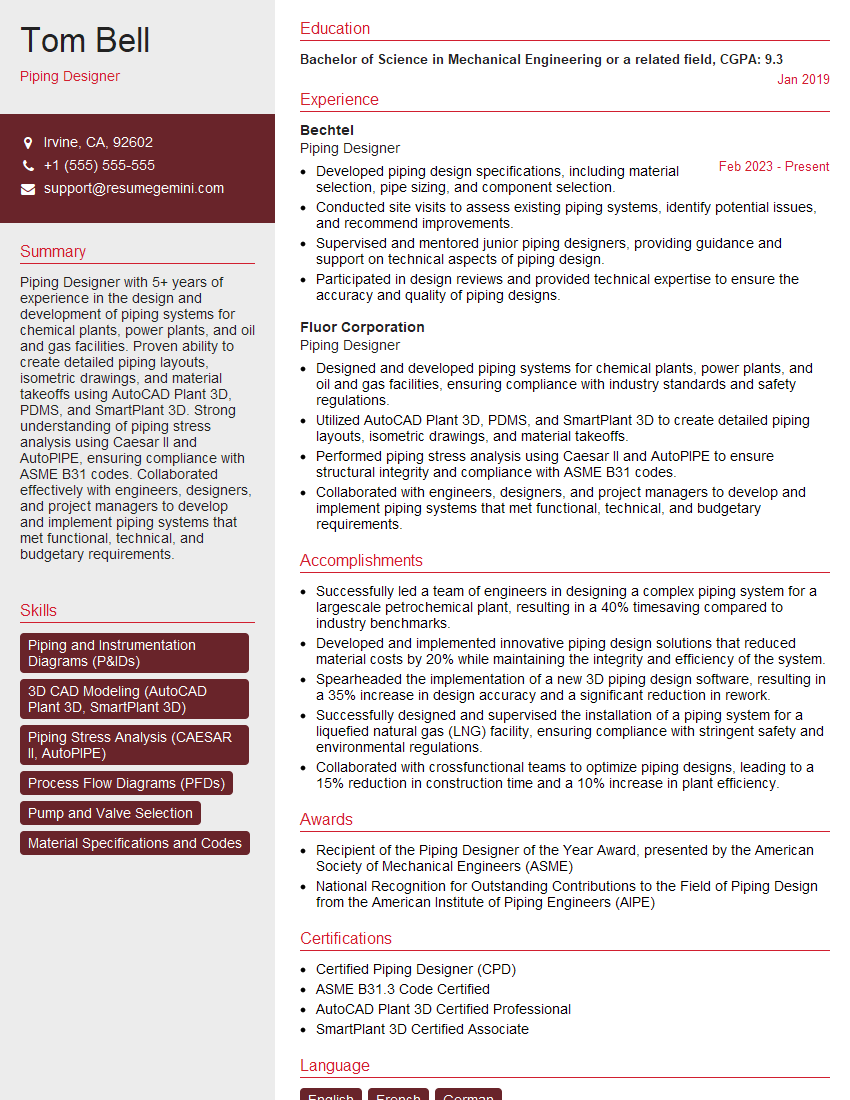Preparation is the key to success in any interview. In this post, we’ll explore crucial Interpreting Piping and Instrumentation Drawings (P&IDs) interview questions and equip you with strategies to craft impactful answers. Whether you’re a beginner or a pro, these tips will elevate your preparation.
Questions Asked in Interpreting Piping and Instrumentation Drawings (P&IDs) Interview
Q 1. Explain the purpose and importance of Piping and Instrumentation Diagrams (P&IDs).
Piping and Instrumentation Diagrams (P&IDs) are schematic drawings used in engineering and process industries to depict the process flow, instrumentation, and piping systems of a plant or facility. They are crucial for design, construction, operation, and maintenance. Think of them as the blueprints for a plant’s circulatory system – showing how materials move, how processes are controlled, and where all the vital components are located.
Their importance stems from their ability to communicate complex information clearly and concisely to a wide range of professionals, including engineers, technicians, and operators. A well-executed P&ID ensures everyone is on the same page, reducing miscommunication and costly errors during design, construction, and operation. They are essential for safety, troubleshooting, and efficient plant management.
Q 2. Describe the different types of P&ID symbols and their meanings.
P&ID symbols are standardized graphical representations of equipment, piping, instrumentation, and control systems. Different industries may use slightly varied symbols, but most adhere to common standards like ISA (International Society of Automation). Key symbols include:
- Equipment: Vessels (tanks, reactors), pumps, compressors, heat exchangers, are depicted with specific shapes and labels. For example, a horizontal cylindrical tank is usually shown as a horizontal rectangle.
- Piping: Lines of varying thickness and styles represent pipes, showing flow direction with arrows. Different line types might denote different materials or services (e.g., steam, water).
- Valves: Various symbols denote different valve types (globe, gate, ball, check, etc.), each with its own specific graphical representation which indicates functionality. For example, a globe valve is typically a circle with a stem, while a gate valve is depicted as a circle with a wedge.
- Instrumentation: Sensors (temperature, pressure, level, flow), transmitters, controllers, and actuators are shown with unique symbols that often include identifying tags. For example, a temperature transmitter might be shown as a circle with a thermometer symbol inside.
Understanding these symbols is fundamental to interpreting P&IDs. A comprehensive legend, usually included on the drawing itself, should define all used symbols.
Q 3. How do you interpret valve symbols on a P&ID?
Valve symbols on a P&ID are crucial as they depict the flow control elements within the system. Interpretation involves recognizing the valve type and understanding its function. The symbol itself often provides clues – a circle might indicate a globe valve, while a circle with a wedge suggests a gate valve. Additional information may be included, such as the valve’s size, material, and actuation type (manual, pneumatic, electric).
For example, a circle with a stem and a ‘FV’ tag might represent a ‘Flow Valve’. The position of the valve in the line also implies a specific function. A closed valve would typically block flow and an open valve will permit flow.
It’s also important to examine the associated instrumentation. A valve with an actuator symbol suggests automated control. Understanding these details allows for accurate comprehension of flow paths and control strategies.
Q 4. What are the standard conventions used in P&ID drawings?
Standard conventions in P&ID drawings ensure clarity and consistency. These conventions include:
- Flow Direction: Arrows clearly indicate the direction of fluid flow through pipes and equipment.
- Line Sizing: Line thickness often correlates with pipe diameter, though this isn’t always to scale.
- Instrumentation Tags: Tags uniquely identify instruments and equipment (e.g., TI-101 for a temperature indicator).
- Line Numbering: Pipes are usually assigned numbers to track their paths through the system.
- Symbol Standardization: Use of standardized symbols (as described earlier) allows engineers across companies to understand P&IDs easily.
- Revision Control: Clear revision markings keep track of changes made to the drawing.
Adherence to these conventions allows for easy interpretation and understanding, minimizing ambiguity and errors.
Q 5. How do you identify process flow and equipment on a P&ID?
Identifying process flow and equipment on a P&ID starts by recognizing the symbols. Equipment symbols are usually larger and more prominent than piping symbols. Arrows indicate the direction of material flow through the system. By following these arrows and tracing the lines, you can easily determine the path a material takes.
For example, you’d likely see a pump symbol followed by piping, leading to a vessel or reactor, clearly showing the process flow. Each equipment item has a tag, usually a unique identifier, that allows for further details from the equipment list or other associated documents.
It helps to start from the beginning of the process and systematically trace the flow path to understand how different components are interconnected. It’s a bit like following a roadmap for the plant’s operations.
Q 6. Explain the process of interpreting instrument tags and loops.
Instrument tags and loops are fundamental to understanding control systems on P&IDs. Instrument tags are alphanumeric codes uniquely identifying each instrument, typically following a consistent pattern such as ‘TI’ for Temperature Indicator, ‘FIC’ for Flow Indicator Controller etc. They provide a concise and unambiguous way to refer to specific instruments.
Instrument loops depict the flow of signals between instruments. For instance, a level transmitter (LT-101) might send a signal to a controller (LC-101), which in turn commands a control valve (FV-101) to maintain a set level in a tank. The loop diagram displays this signal path. Following these loops helps understand how instruments and control systems interact to manage the process.
By tracing the instrument tags and following the loops, you get a grasp of how the control system affects the overall process flow and maintains operation within the desired parameters.
Q 7. How do you identify control loops and their functions on a P&ID?
Control loops on a P&ID are depicted through instrument tags and their interconnections. A control loop generally consists of a sensor (measuring a process variable), a transmitter (converting the measurement into a signal), a controller (comparing the measured variable to a setpoint), and an actuator (making adjustments to the process based on the controller’s output).
For instance, a level control loop might include a level transmitter (LT), a level controller (LC), and a control valve (FV). The transmitter sends the level information to the controller, which compares it to the desired setpoint and sends an appropriate signal to the valve to adjust the flow, maintaining the level within the specified range.
Identifying these loops helps understand how different aspects of the process are controlled and maintained. Understanding the function of each instrument within the loop reveals how the process is regulated to its intended operation.
Q 8. How do you use a P&ID to troubleshoot process issues?
P&IDs are invaluable tools for troubleshooting process issues. Think of them as a plant’s blueprint, showing the intricate network of pipes, valves, instruments, and equipment. When a problem arises, the P&ID guides you through the system, allowing you to systematically investigate the source.
For example, if a reactor isn’t reaching the desired temperature, you’d use the P&ID to trace the temperature measurement instrument (e.g., a thermocouple) back to its transmitter and then to the control system. The P&ID would reveal the piping and instrumentation related to heating the reactor, allowing you to check for blockages, valve malfunctions, or issues with the heating system itself. You’d systematically check each component, guided by the connections shown on the drawing. You might find a faulty valve, a clogged pipe, or a malfunctioning temperature controller—the P&ID provides a roadmap to identify the root cause.
Another example: Imagine a pressure surge in a pipeline. The P&ID will show the pressure relief valves (PRVs) and safety instrumented systems (SIS) associated with that pipeline. You can use the P&ID to verify if the PRVs functioned correctly, or if there’s an indication of a SIS failure. It acts as a guide, showing what could have contributed to the pressure surge and where to look for evidence of malfunction.
Q 9. How are safety instrumented systems (SIS) represented on a P&ID?
Safety Instrumented Systems (SIS) are crucial for plant safety and are clearly represented on P&IDs. They’re typically shown using specific symbols and logic diagrams which are often integrated directly into the P&ID. You’ll often see SIS components identified with a distinctive prefix, such as ‘SIS’ or a similar identifier.
Common SIS elements depicted on a P&ID include:
- Emergency Shutdown Valves (ESDVs): These valves automatically shut off the flow of hazardous materials in case of an emergency. They’re often shown with a distinct symbol and a clear indication of their connection to the SIS logic solver.
- Logic Solvers (PLCs or other control systems): The ‘brains’ of the SIS, these components receive signals from sensors and activate ESDVs or other safety devices according to pre-programmed logic. The P&ID shows the input and output connections to the solver.
- Sensors and Transmitters: These devices detect abnormal conditions (e.g., high pressure, high temperature) that trigger the SIS. Their connections to the logic solver are displayed on the P&ID.
- Safety Instrumented Functions (SIFs): These represent the complete safety logic. The P&ID will show the relationship between sensors, logic solvers, and actuators which achieve the safety function.
Think of it like this: the P&ID illustrates how the ‘safety net’ interacts with the process, giving a comprehensive view of the safety systems in place.
Q 10. What are the differences between a P&ID and a process flow diagram (PFD)?
While both P&IDs and Process Flow Diagrams (PFDs) depict process flow, they serve different purposes and differ significantly in their level of detail. The PFD is a high-level overview, a simplified representation of the process showing major equipment and flow streams. It’s useful for initial process design and understanding the general process flow.
The P&ID, on the other hand, is a detailed engineering drawing that shows every piece of equipment, piping, instrumentation, and control logic. It’s used for engineering design, construction, operation, and maintenance.
- PFD: Shows major process streams, unit operations, and equipment. It omits detailed instrumentation and piping.
- P&ID: Shows all equipment, piping, valves, instrumentation, and control systems with complete detail, including line sizes, materials, and instrument tags.
Imagine a recipe: The PFD is like a summary of the recipe, listing the main ingredients and steps. The P&ID is like the detailed instructions, specifying the exact amounts of each ingredient, cooking times, and equipment needed.
Q 11. Explain how P&IDs are used in the design, construction, and operation of a plant.
P&IDs are fundamental throughout a plant’s lifecycle:
- Design: Engineers use P&IDs to design the process, sizing equipment, specifying instrumentation, and defining control strategies. The P&ID forms the basis for procurement and engineering specifications.
- Construction: Contractors use the P&ID as the primary reference document for installing equipment and piping. It guides the physical construction of the plant, ensuring everything is correctly connected.
- Operation: Operators use the P&ID to understand the process, monitor equipment performance, and troubleshoot problems. It’s a critical tool for daily operations.
In essence, the P&ID is the central document that links the design, construction, and operation phases, ensuring consistency and accuracy across the entire project lifecycle. It serves as a single source of truth for the plant’s process and instrumentation.
Q 12. Describe the role of P&IDs in HAZOP studies.
HAZOP (Hazard and Operability) studies are crucial for identifying potential hazards in a process. The P&ID is the primary document used during a HAZOP study. The team uses the P&ID to systematically review each section of the process, considering deviations from the intended operating parameters (e.g., higher pressure, lower temperature).
For each deviation, the team asks guiding questions to identify potential hazards and assess their risks. The P&ID helps visualize the process flow and identify potential consequences of each deviation, assisting in the development of appropriate safeguards.
For example, a HAZOP might identify a potential high-pressure situation in a reactor. The P&ID would be used to trace the pressure relief system, checking the adequacy of the safety valves and confirming their proper sizing and connection to the SIS. The visual representation on the P&ID allows the team to quickly and effectively analyze the potential impact of deviations, leading to safer and more reliable plant design.
Q 13. How do you identify potential hazards or risks from a P&ID?
Identifying potential hazards from a P&ID involves a systematic review of the drawing, looking for areas with potential for failure or hazardous conditions. It requires understanding process chemistry, equipment limitations, and safety systems. Here are some key aspects to look for:
- Lack of Redundancy: Single points of failure (e.g., a single valve controlling a critical flow) should be flagged for potential improvement.
- Complex Interconnections: Complicated piping arrangements or control systems can introduce unforeseen hazards.
- Inadequate Safety Systems: Insufficient or improperly designed safety relief valves, emergency shutdown systems, or other safety devices are significant risks.
- Incompatible Materials: Mismatched materials in piping or equipment can lead to corrosion or leaks.
- Lack of Instrumentation: Missing or insufficient instrumentation can limit the ability to monitor critical parameters and detect potential problems.
Think of it like a detective inspecting a crime scene – the P&ID provides all the clues needed to identify potential hazards. Careful review and a thorough understanding of process principles are key to uncovering these potential problems.
Q 14. How do you interpret instrument specifications from a P&ID?
Instrument specifications are crucial for ensuring the correct instrumentation is installed and functions as designed. On a P&ID, instrument specifications are often represented by instrument tags and accompanying data sheets.
Each instrument is assigned a unique tag (e.g., `TI-101` for temperature indicator). This tag links to a data sheet or specification document that defines the instrument’s type, manufacturer, model, range, accuracy, and other technical details. For example, `TI-101` might refer to a temperature indicator with a specific range (e.g., 0-100°C), accuracy, and communication protocol.
The P&ID shows the instrument’s location within the process and its connections to other equipment and instruments. By cross-referencing the instrument tag with the data sheet, you gain a complete understanding of the instrument’s purpose, capabilities, and limitations within the plant’s overall operation. It’s all about understanding the instrument’s functionality and its role in the overall process control scheme.
Q 15. Explain the importance of proper P&ID documentation and updates.
Proper P&ID documentation is the cornerstone of any successful process plant project. Think of it as the blueprint for a complex system, detailing every pipe, valve, instrument, and piece of equipment. Without accurate and up-to-date P&IDs, installation, commissioning, operation, and maintenance become incredibly difficult, expensive, and potentially hazardous.
- Safety: P&IDs clearly show the flow of hazardous materials, highlighting potential safety risks like leaks or explosions. Regular updates ensure that these risks are continuously assessed and mitigated.
- Efficiency: Accurate P&IDs streamline operations. They provide clear instructions for maintenance, troubleshooting, and process optimization, minimizing downtime and maximizing production.
- Cost Savings: Changes and modifications are less costly when documented on updated P&IDs. Incorrect or outdated documentation leads to costly rework, delays, and potential safety incidents.
- Collaboration: P&IDs act as a central communication tool for all project stakeholders – engineers, technicians, contractors, and operators. Clear and updated drawings ensure everyone is on the same page.
For example, imagine a chemical plant where a crucial valve is incorrectly identified or labeled in an outdated P&ID. This could lead to a serious safety incident during maintenance or an inefficient shutdown process. Regular updates and verification procedures prevent such situations.
Career Expert Tips:
- Ace those interviews! Prepare effectively by reviewing the Top 50 Most Common Interview Questions on ResumeGemini.
- Navigate your job search with confidence! Explore a wide range of Career Tips on ResumeGemini. Learn about common challenges and recommendations to overcome them.
- Craft the perfect resume! Master the Art of Resume Writing with ResumeGemini’s guide. Showcase your unique qualifications and achievements effectively.
- Don’t miss out on holiday savings! Build your dream resume with ResumeGemini’s ATS optimized templates.
Q 16. What software packages are you familiar with for viewing and editing P&IDs?
I’m proficient in several software packages used for P&ID creation, viewing, and editing. My experience includes:
- AutoCAD: A widely used CAD software for creating and managing detailed engineering drawings, including P&IDs. I am skilled in using its features for creating and modifying P&ID symbols, annotating drawings, and managing revisions.
- SmartPlant P&ID: A specialized software package designed specifically for P&ID development. This software provides intelligent features such as automatic tag generation, data management, and integration with other engineering tools.
- COMSOL Multiphysics: While primarily used for simulation, COMSOL’s capabilities are useful for validating P&ID designs by integrating simulations of fluid flow, heat transfer and other process parameters.
- AVEVA PDMS: A 3D model-based design tool that integrates seamlessly with P&ID data. It allows for detailed 3D modeling of the plant based on the P&ID and facilitates better understanding of system layout and interconnections.
My expertise spans both 2D and 3D modeling, ensuring I can handle diverse projects and efficiently utilize various software functionalities to meet specific project requirements.
Q 17. How do you verify the accuracy and completeness of a P&ID?
Verifying the accuracy and completeness of a P&ID is a crucial step, involving a multi-faceted approach. It’s like a detective investigating a complex case; you need to examine all the evidence and cross-reference it carefully.
- Cross-referencing: I thoroughly cross-reference the P&ID with other engineering documents, like equipment datasheets, instrument specifications, and process flow diagrams (PFDs). Any discrepancies need to be investigated and resolved.
- Symbol verification: I meticulously check the accuracy and consistency of symbols and their tagging, ensuring that every element is correctly represented and labeled according to the relevant industry standards.
- Data validation: I verify the accuracy of process parameters, such as flow rates, pressures, and temperatures, against process design specifications. This is especially important for ensuring that the P&ID reflects the actual operating conditions.
- Walkdowns (if possible): Whenever feasible, I conduct physical walkdowns of the process area to verify the P&ID against the installed equipment and piping. This is invaluable for identifying discrepancies between the design and the actual installation.
- Peer review: I participate in and actively contribute to peer review sessions to ensure independent verification and validation of P&ID content.
For instance, in one project, a cross-reference check revealed a mismatch between the P&ID valve size and the specification sheet, which could have led to process inefficiencies. Early detection through verification prevented this issue from escalating during installation.
Q 18. Describe your experience with P&ID review and approval processes.
I have extensive experience with P&ID review and approval processes, following a structured approach that ensures comprehensive checks and balances. My experience encompasses the following:
- Initial Review: This initial review covers the completeness and accuracy of the P&ID, checking for proper symbology, data consistency, and compliance with relevant standards.
- Discipline Review: Each engineering discipline (process, instrumentation, mechanical, etc.) reviews the P&ID from their respective perspectives, focusing on areas relevant to their expertise.
- Management Review: A final review from management ensures overall quality and adherence to project goals and standards. This also provides oversight and approvals.
- Revision Control: I am proficient in using revision control systems to track changes, updates, and approvals across different versions of the P&ID. This ensures transparency and accountability.
- Documentation: I thoroughly document all review comments, approvals, and changes to maintain a complete audit trail.
For example, in a past project, a discrepancy in piping material specifications was identified during the discipline review, preventing a potentially costly error during procurement and installation.
Q 19. How do you handle discrepancies or conflicts on a P&ID?
Handling discrepancies or conflicts on a P&ID requires a systematic approach. It’s like resolving a disagreement – you need to understand both sides before finding a solution.
- Identify and Document: The first step is to clearly identify and document all discrepancies or conflicts. This includes noting the specific location on the P&ID and the nature of the conflict.
- Investigate: I thoroughly investigate the root cause of the discrepancy, consulting relevant documents and stakeholders to understand the origin of the conflicting information.
- Resolve: Once the root cause is identified, I work with the relevant parties (designers, engineers, contractors) to resolve the conflict, ensuring that the solution is technically sound, safe, and compliant with standards.
- Document Resolution: The resolution is documented and formally communicated to all stakeholders. This ensures everyone is aware of the change and its impact.
- Update P&ID: The P&ID is updated to reflect the agreed-upon resolution, with appropriate revision control measures in place.
A common conflict is between the process and instrumentation disciplines; for example, a conflict in the control strategy for a specific valve could arise. Through collaboration and clear communication, we can find the optimal solution that satisfies both disciplines, avoiding future problems.
Q 20. Explain how P&IDs are used during equipment installation and commissioning.
P&IDs are indispensable during equipment installation and commissioning. They serve as the primary reference document, guiding the entire process from start to finish.
- Installation: The P&ID helps locate and install equipment and piping precisely according to the design. It guides the construction team in connecting pipes, valves, and instruments correctly, ensuring a seamless integration of the system.
- Pre-commissioning: The P&ID is used to verify that all equipment and piping have been installed according to the design, and to prepare the system for testing.
- Commissioning: During commissioning, the P&ID provides essential information for testing the system’s functionality, performance, and safety. The P&ID guides the testing team through the step-by-step process, helping them identify and rectify any problems early on.
- Loop Testing: The P&ID is crucial for conducting loop testing, which verifies the proper operation of individual control loops in the system. This ensures that all instrumentation and control systems are working as intended.
Imagine trying to assemble a complex machine without its instructions. Similarly, installing and commissioning equipment without a detailed P&ID would be extremely challenging, time-consuming, and error-prone.
Q 21. Describe your understanding of P&ID revisions and change management.
Understanding P&ID revisions and change management is essential for maintaining the integrity and accuracy of the documentation. It’s like keeping a detailed history of a document, ensuring that everyone is working from the latest and correct version.
- Revision Control System: I use revision control systems (e.g., version control software) to manage changes effectively. This ensures that each revision is properly documented and tracked, avoiding confusion and ensuring everyone uses the most up-to-date version.
- Change Requests: All changes to the P&ID must be initiated through formal change requests, which are reviewed and approved by the appropriate authorities. This process ensures that all changes are well-considered and controlled.
- Document Revision Numbering: A clear system of revision numbering and versioning is essential to differentiate various P&ID versions and their corresponding changes.
- Change Log: A detailed change log is maintained, documenting the nature of changes, the date of implementation, and the responsible individual. This creates a transparent record of all updates.
For example, a change request might be submitted to modify a valve size to improve system performance. This request is then reviewed, approved, and the P&ID is updated with the correct information, along with the appropriate revision number and entry in the change log.
Q 22. How would you explain a complex P&ID to a non-technical audience?
Imagine a P&ID as a blueprint for a complex plumbing system, but instead of water, it handles chemicals, gases, or other process fluids. It shows how everything connects – the pipes, valves, pumps, and instruments – so you understand the flow and control of the process. For a non-technical audience, I’d focus on the big picture: What is the system’s purpose? What are the main components? How do they work together? I’d use analogies they can relate to, like a road map or a flowchart. I’d avoid technical terms unless absolutely necessary, and I’d use simple language and visuals to illustrate the process.
For example, instead of saying “The process stream enters a jacketed reactor,” I might say, “The material flows into a special container that’s heated or cooled to control the reaction.”
Q 23. How do you identify and interpret different types of piping materials and specifications on a P&ID?
P&IDs use symbols and designations to specify piping materials. For instance, a line might be labeled as “CS 6” indicating carbon steel pipe, Schedule 60. Other common materials include stainless steel (SS), PVC, and various alloys. The specifications often include the material grade, schedule (wall thickness), and diameter. You’ll often find this information in a legend or in a separate material specification document referenced by the P&ID. Sometimes, the material might even be indicated using color-coding within the drawing itself, which is always specified in the drawing key.
For example, Schedule 40 stainless steel 316 might be indicated as SS316 SCH40. Understanding these codes is crucial for proper maintenance, material selection, and safety. Incorrect material selection could lead to corrosion, leaks, or even catastrophic failures.
Q 24. Explain the importance of understanding P&ID isometrics in relation to the main drawing.
Isometrics provide a 3D representation of the piping system’s layout, supplementing the 2D view of the P&ID. While the P&ID shows the overall process flow and instrumentation, the isometric drawing shows the exact physical path of each pipe, including bends, fittings, and support structures. This is crucial for fabrication, installation, and maintenance. Imagine the P&ID as a roadmap, showing the general route, while the isometric is a detailed street-level map showing all the twists and turns.
A discrepancy between the P&ID and the isometric could lead to errors during construction or maintenance, resulting in costly rework or safety hazards. Therefore, careful cross-referencing between the two is essential.
Q 25. Describe your experience using P&IDs for maintenance and troubleshooting.
I’ve extensively used P&IDs for troubleshooting and maintenance in various process plants. For instance, when a process unit malfunctions, I’d first consult the P&ID to understand the affected process stream and its connected components. By tracing the flow path and examining the instrumentation, I can pinpoint potential causes of the malfunction. This approach often involves checking pressure and temperature readings at various points in the system, verifying valve positions, and checking for leaks.
In one instance, we experienced an unexpected pressure drop in a section of the pipeline. Using the P&ID, we identified a relief valve that was unexpectedly opening. Further investigation revealed a build-up of scale within the valve, indicating a need for maintenance.
Q 26. How would you approach interpreting a P&ID for a system you are unfamiliar with?
Approaching an unfamiliar P&ID requires a systematic approach. I’d begin by familiarizing myself with the process description and any accompanying documentation. Then, I’d systematically trace the process flow, paying close attention to the major equipment (reactors, heat exchangers, etc.) and their interconnections. I’d use the P&ID legend to decode the symbols and understand the function of each instrument. Parallel to this, I would verify the validity of the document by verifying the revision number and checking for any applicable revisions or updates.
A key strategy is to start with the process input and output points and systematically follow the process flow, examining each component to understand its role in the overall process. Using this approach, you can build a comprehensive understanding of even the most complex P&IDs.
Q 27. Explain the relationship between P&IDs and other engineering documents, such as datasheets and specifications.
P&IDs are central to a project’s documentation, forming a vital link between various engineering documents. Datasheets for equipment (pumps, valves, etc.) provide detailed specifications and performance characteristics, referencing information found on the P&ID. Similarly, equipment specifications and material specifications clarify the details of the components illustrated symbolically on the P&ID. The P&ID provides the overall context, while these documents provide the fine details.
For example, the P&ID shows a pump’s location and flow rate, while its datasheet specifies its capacity, horsepower, and manufacturer. Consistency between these documents is crucial for a successful project.
Q 28. How do you use P&IDs to ensure compliance with industry standards and regulations?
Compliance is paramount. I use P&IDs to ensure adherence to industry standards and regulations, such as ASME, API, and ISA standards relevant to the specific process industry and geographic location. I verify that the P&ID includes the necessary safety devices (relief valves, safety interlocks, etc.), that the instrumentation meets the required accuracy and safety levels, and that the piping materials and design comply with applicable codes. Any deviations from these standards require justification and documentation.
Regular review of P&IDs and associated documents is critical in ensuring ongoing compliance and identifying potential risks before they become problems. During audits and inspections, I’ve found the P&IDs to be a key document in demonstrating compliance and providing clear traceability.
Key Topics to Learn for Interpreting Piping and Instrumentation Drawings (P&IDs) Interview
Ace your upcoming interview by mastering these essential concepts related to Piping and Instrumentation Drawings (P&IDs). Understanding these will not only demonstrate your technical skills but also showcase your problem-solving abilities.
- P&ID Symbols and Notation: Learn to identify and interpret the various symbols used in P&IDs, including valves, instruments, pumps, and other equipment. Understanding their meaning is fundamental to reading any P&ID.
- Process Flow and Logic: Practice tracing the flow of fluids and materials through the system. Be prepared to explain the sequence of operations and the logic behind the process design.
- Instrumentation and Control Systems: Familiarize yourself with different types of instruments and their functions within the process. Understand how these instruments are interconnected and how they contribute to overall process control.
- Piping Systems and Components: Understand the different types of pipes, fittings, and valves used. Be able to identify materials of construction and their suitability for specific applications.
- Process Safety and Hazards: Demonstrate an understanding of potential hazards and safety considerations associated with the process. Discuss how P&IDs contribute to safety procedures and risk mitigation.
- Practical Application & Problem Solving: Prepare to analyze hypothetical scenarios presented using P&IDs. This might involve identifying potential issues, proposing solutions, or explaining the impact of changes to the system.
- Industry Standards and Best Practices: Familiarity with relevant industry standards and best practices for P&ID development and interpretation is highly valuable.
Next Steps
Mastering P&IDs is crucial for advancement in your engineering career, opening doors to exciting opportunities and increased responsibility. To maximize your chances of landing your dream role, a strong, ATS-friendly resume is essential. ResumeGemini is a trusted resource that can help you craft a compelling resume that highlights your P&ID expertise. We provide examples of resumes tailored to Interpreting Piping and Instrumentation Drawings (P&IDs) to give you a head start. Take the next step towards your successful career today!
Explore more articles
Users Rating of Our Blogs
Share Your Experience
We value your feedback! Please rate our content and share your thoughts (optional).
What Readers Say About Our Blog
Live Rent Free!
https://bit.ly/LiveRentFREE
Interesting Article, I liked the depth of knowledge you’ve shared.
Helpful, thanks for sharing.
Hi, I represent a social media marketing agency and liked your blog
Hi, I represent an SEO company that specialises in getting you AI citations and higher rankings on Google. I’d like to offer you a 100% free SEO audit for your website. Would you be interested?

